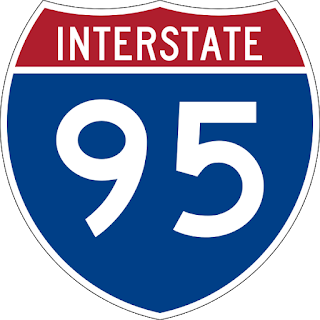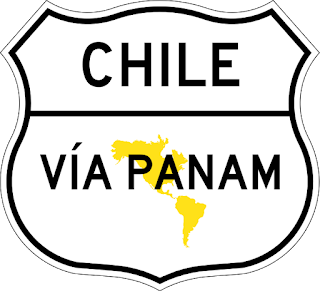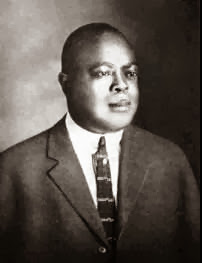 |
| The King of Swing Does His Thing. |
Today we continue our exploration of Chicago Jazz. Last week, we talked about some of the hot jazz pioneers that passed through the city of Chicago on the way to fame in other places. This week we're going to talk about one of Chicago's native sons. In Chicago back in the jazz days, it was common for businesses on Chicago's Maxwell Street to the setup stages in front of their stores and let the local jazz musicians play to draw in customers. Those street level performances would have had an effect on our native son.
Born in 1909, Benny Goodman was the 9th of 13 children to grow up in a poor Jewish family on the east side of Chicago. Early in his life Benny Goodman showed an aptitude for music. At the age of 10 he was given clarinet lessons with a local Synagogue, providing his foundation in music. Goodman was a quick student and shortly join the school band and began performing in numerous other bands at a young age. He made his professional debut in 1921, 1 year before beginning high school. 1923 he joined Musicians Union and by 1924 at age 14, following the death of his father, he quit school to performing in local bands to help support his family. One band featuring legendary jazz performer Bix Beiderbecke. When Goodman was just 16 he was hired by the Ben Pollack band and went with them to Los Angeles, staying on with the band for four years. At this point, the Chicago portion of the Benny Goodman story largely winds down. His star was still rising though.
During the late 20's and early 30's, Benny Goodman relocated to New York, which really ends the Chicago part of our story. But to follow up on the heights Goodman's star was to rise to, we continue. While in New York, Goodman was an session musician who worked with such jazz greats as Glenn Miller, Tommy Dorsey, Gene Krupa, Coleman Hawkins and a young Billie Holiday. n 1934 he created his first band and also auditioned for the radio program Lets Dance. It was a successfull audition and the band was booked for the program. As part of his preparation for the program, Goodman was expected to provide arrangements for the dance performances. He enlisted the help of early jazz great, Fletcher Henderson, who had fallen on hard times with the crash of the stock market in 1929. Goodman helped Henderson solve some financial problems and was paid with Henderson's manuscripts of arrangements and sheet music. Goodman also hired several of Henderson's musician to teach the hot jazz playing style to his band members. The program featured three bands, with Goodman's band playing during the last hour at starting at 11:30pm New York time. Due to the late hour, the band did not attract a lot of attention on the East Coast. In 1935, they were without work, as the program was cancelled do to a strike by the show sponsor, Nabisco.
Hitting the road in May of 1935, the band began with an engagement in Manhattan that proved to be disappointing. In an attempt to appear to a popular audience, the Goodman band played slower "sweet" numbers, rather than the Henderson style of swing they played on late night radio. The audience was largely unimpressed. The tour continued along the same vein with fairly disinterested audiences. By August, the band was on the verge of collapse due to financial difficulties and a frustration with indifferent audiences. As their tour reached the west coast, the Benny Goodman band was scheduled to play for 3 weeks at the Palomar Ballroom in Los Angeles. During their first performance they continue to play the mellow Sweet Music that had failed to inspire audiences across the country. Goodman's drummer, the legendary Gene Krupa, turned to Goodman on the bandstand and said "If we're going to die, Benny, let's die playing our own thing." With that, the band began to play one of the hot swing numbers. The crowd went crazy! The kids jumped up out of their seats and began to dance. What Goodman did not realize was that the Los Angeles audience got to hear his set at 930 in the evening instead of 11:30 as they did back east, which made his music popular among the LA youth. They had also been hearing a few of his records being spun on the KFWB radio in Los Angeles, so when the Goodman band arrived they were ready to hear them. The Palomar shows drew a lot of attention and is considered by many to be the birth of the swing era.
In 1937 Goodman and his band were given the opportunity to perform at Carnegie Hall, this gave the jazz and swing scene a credibility to the world of "serious music" that it had not had prior to that. Goodman;s fame continued to grow. Ultimately he would be given the title The King of Swing. He would provide the soundtrack for World War II. A film would be made (over)dramatizing his life story. As the swing era wound down and the costs of the large touring bands became unsustainable, Goodman would switch gears and pursue a successful career in classical music composition. He would lead a long and productive life before passing away in 1986 at the age of 77. Not bad for a kid from the poor side of Chicago.
Compared to his legacy in music, Benny Goodman is somewhat under represented in my music collection. He shows up on a variety of compilations and anthologies of the Swing Era and World War II that I have, but I only have one album. So lets start off this weeks additions to the Route 66 playlist. As always, the song titles links you where you can download the songs, whenever possible. The videos are often similar versions offered for comparisons sake and for entertainment value.
Probably the most well mastered recordings are from Ken Burns excellent documentary Jazz : A Film By Ken Burns.With the documentaries release a five disc set was issued. I'm glad I made a point of picking it up. While Burns loses steam in the 1950's and lapses in his coverage, his work in most of the film is as detailed and entertaining a presentation of jazz history as you will find. The "King Porter Stomp" featured in the film is from a 1935 recording and is the first Benny Goodman song to be added to our playlist.
- King Porter Stomp Ken Burns Jazz Benny Goodman 3:11
Also from Ken Burns Jazz, "Sing, Sing, Sing (With A Swing)" was originally released in 1937. Drummer, Gene Krupa pounds a driving tribal rhythm to start the number before the band kicks in with a swinging melody. Goodman does some absolutely rollicking solos trading breaks with Krupa, whose drum solos put a lot of modern rock drum solos to shame. It was the band's signature song that they would often end live sets with. You can hear why.
- Sing, Sing, Sing (With A Swing) Ken Burns Jazz Benny Goodman 8:40
The 1939 recording of "Rose Room" featuring the Benny Goodman Sextet was also in the epic documentary and is now part of my epic playlist..
- Rose Room Ken Burns Jazz Benny Goodman & His Orchestra 2:50
This next set of Benny Goodman songs is from a three disc various artist set called Music From The War Years The Big Band Era . I picked up the third disc used at a library book sale. It has a mini set of Benny Goodmans Orchestra that are now a mini set on my already enormous Old Highway Notes Route 66 playlist. (If you think Chicago has a lot of music for us to explore, just wait until we get to Texas!)
- Stompin' At The Savoy Music From The War Years The Big Band Era Vol. 3 Benny Goodman 2:28
"One O' Clock Jump" was featured in the quite dramatized bio-pic The Benny Goodman Story with Steve Allen playing Goodman, The clip is from the films styled account the infamous Palomar Ballroom performance.
- One O'Clock Jump Music From The War Years The Big Band Era Vol. 3 Benny Goodman 7:40
- Let's Dance Music From The War Years The Big Band Era Vol. 3 Benny Goodman 0:48
A much shorter version of "One O'Clock Jump" also makes the list from another swing anthology I picked up over the years. The YouTube clip is from the 1938 Carnegie Hall show.
- One O'Clock Jump Anthology Of Big Band Swing Benny Goodman 3:10
I have no idea when this was recorded but it is apparently a latter day stereo recording, according to Amazon customer comments, probably from the 50's.
- Let's Dance The Roots Of Swing N' Jive: Minnie The Moocher Benny Goodman 2:14
- Sing Sing Sing (With A Swing) The Kings Of Swing Benny Goodman 7:58
- Limehouse Blues The Kings Of Swing Benny Goodman 2:36
- King Porter Stomp The Kings Of Swing Benny Goodman 2:55
- Henderson Stomp The Kings Of Swing Benny Goodman 2:28
With the assorted loose tracks added to the list I turn to the one album of Goodman's music in my collection. It is an average budget compilation from 1988 called. "Swing Back with Benny Goodman". It is out of print and Amazon currently only offers a used cassette version. Here is the track listing:
1. One O'clock Jump 7:42Since I had some success looking in Archive for the artists I covered in last weeks post, I thought I would see what it had for Benny Goodman. And there were some good finds.The first track I found was Wolverine Blues from 1928. According to Archive, it was his first recording. You can download it HERE. Or listen to it below:
2. Jersey Bounce 3:03
3. And The Angels Sing 3:10
4. Stompin At The Savoy 2:28
5. Down Town Camp Meeting 2:59
6. Jumpin At The Woodside 3:17
7. Let's Dance 0:45
8. Sing Sing Sing 6:34
9. Get Happy 3:09
10. Stardust 2:54
11. King Porter Stomp 2:30
12. Lady Be Good 5:42
Someone was nice enough to post on Archive.Org the recording of the 1938 Carnegie Hall Show that I told you about earlier. You can download it HERE. Or just listen...
Well, that about does it for this week's Old Highway Notes. Join us next time when we look at star that came down from the heavens into Chicago. I'll explain then. Also, stay with us on Highway 101 as we continue exploring American anthems, while we cross the border from Tijuana Mexico. As a reminder, please answer the question this post started with: I am thinking of adding a 3rd route to the rotation of routes to explore on this blog. I'd love to hear your opinion as to what that route should be. Thanks for reading and I look forward to your comments.
And Now A Word From Our Sponsor...
If you like what you have read here I'd like to ask you a favor. If you purchase any item on Amazon after you link to them in the Amazon banner below, I will get a little something from them. It doesn't cost you any extra and I cannot see what you have purchased.
With your help, I can keep the show on the road for you.
With your help, I can keep the show on the road for you.
You Can Give me a Karma Donation Via PayPal
Keep Traveling!
To read more Old Highway Notes, choose an off ramp and click on the highway sign:
Vista Points
Be social, Get more info, View our YouTube playlist and more



















